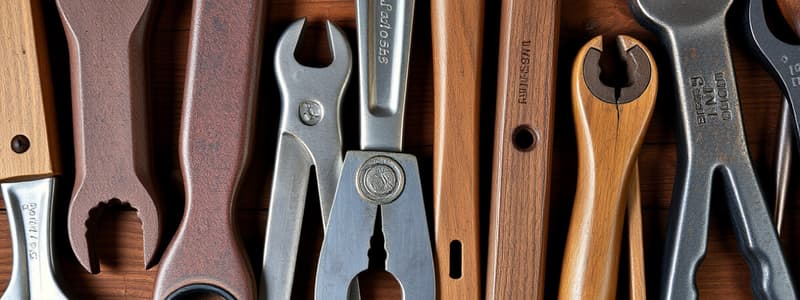Podcast
Questions and Answers
What are hand tools?
What are hand tools?
Simple tools powered by human beings (hand or manually), such as screwdrivers, hammers, shovels, and wrenches
What are the classifications of hand tools? (Select all that apply)
What are the classifications of hand tools? (Select all that apply)
- Boring and drilling tools (correct)
- Finishing tools (correct)
- Layout and measuring tools (correct)
- Cutting tools (correct)
- Percussion tools (correct)
- Holding devices (correct)
- Abrading and scraping tools (correct)
Which of the following is an example of a layout and measuring tool?
Which of the following is an example of a layout and measuring tool?
- Chisel
- Measuring tape (correct)
- Hammer
- Hand saw
What is an example and use of a hand saw?
What is an example and use of a hand saw?
What types of chisels exist?
What types of chisels exist?
Which of the following describes a percussion tool?
Which of the following describes a percussion tool?
What are the types of hammers? (Select all that apply)
What are the types of hammers? (Select all that apply)
Flashcards
Hand Tools Definition
Hand Tools Definition
Manually operated implements like screwdrivers, hammers and wrenches.
Steel Rule
Steel Rule
A tool for precise measurements, often made of steel.
Measuring Tape
Measuring Tape
A flexible tool used for measuring distances.
Try Square
Try Square
Signup and view all the flashcards
Hand Saw
Hand Saw
Signup and view all the flashcards
Mallet
Mallet
Signup and view all the flashcards
Claw Hammer
Claw Hammer
Signup and view all the flashcards
Study Notes
Hand Tools Overview
- Hand tools are simple implements powered manually, including screwdrivers, hammers, shovels, and wrenches.
Classifications of Hand Tools
- Hand tools are categorized into several types:
- Layout and measuring tools
- Cutting tools
- Percussion tools
- Holding devices
- Boring and drilling tools
- Abrading and scraping tools
- Finishing tools
Layout and Measuring Tools
- Examples include:
- Steel rule: For precise measurements.
- Measuring tape: Flexible measuring device for various distances.
- Pencil and chalk: For marking surfaces.
- Try square: Ensures right angles in layouts.
- Marking gauge: Creates consistent marks.
- Mortise gauge: Marks two parallel lines at a set distance.
- Chalk line: Creates straight lines over long distances.
- Spirit level: Checks horizontal and vertical alignment.
- Sliding T-Bevel: Adjusts angles for cutting.
- Combination square: Measures and marks at various angles.
Cutting Tools
- Key cutting tools and their uses:
- Hand saw: Versatile for cutting wood, metals, and plastics.
- Coping saw: Executes intricate cuts on thin materials.
- Tenon saw: Ideal for light bench work and cutting wood lengths.
- Panel/cross-cut saw: Cuts thin sheets and across grain.
- RIP saw: Makes long cuts parallel to the grain.
- Compass saw: Efficient for fine cuts in irregular shapes.
- Chisels: Essential for cutting and shaping wood.
Types of Chisels
- Various chisels suited for specific tasks:
- Bevel edged chisel: Removes waste in trenches and for paring.
- Firmer chisel: General purpose for timber paring.
- Mortise chisel: Designed for heavy-duty mortising tasks.
Percussion Tools
- Key percussion tools:
- Mallets: Used to strike chisels and other tools without damaging them.
- Hammer: General-purpose tool for driving nails or breaking objects.
Types of Hammers
- Common hammers:
- Claw hammer: Versatile for driving and removing nails.
- Warrington hammer: Smaller, designed for fine work like cabinetry.
Studying That Suits You
Use AI to generate personalized quizzes and flashcards to suit your learning preferences.




